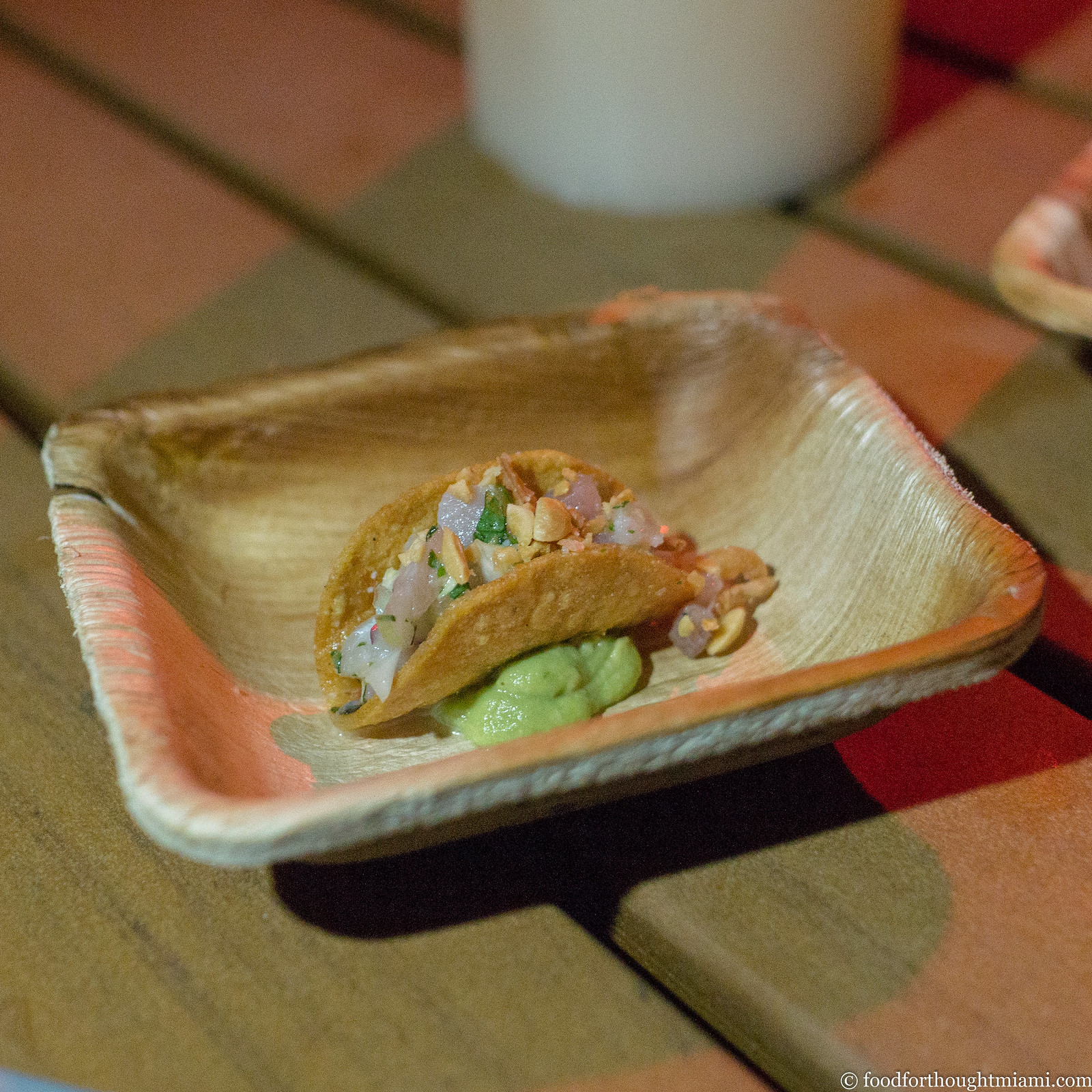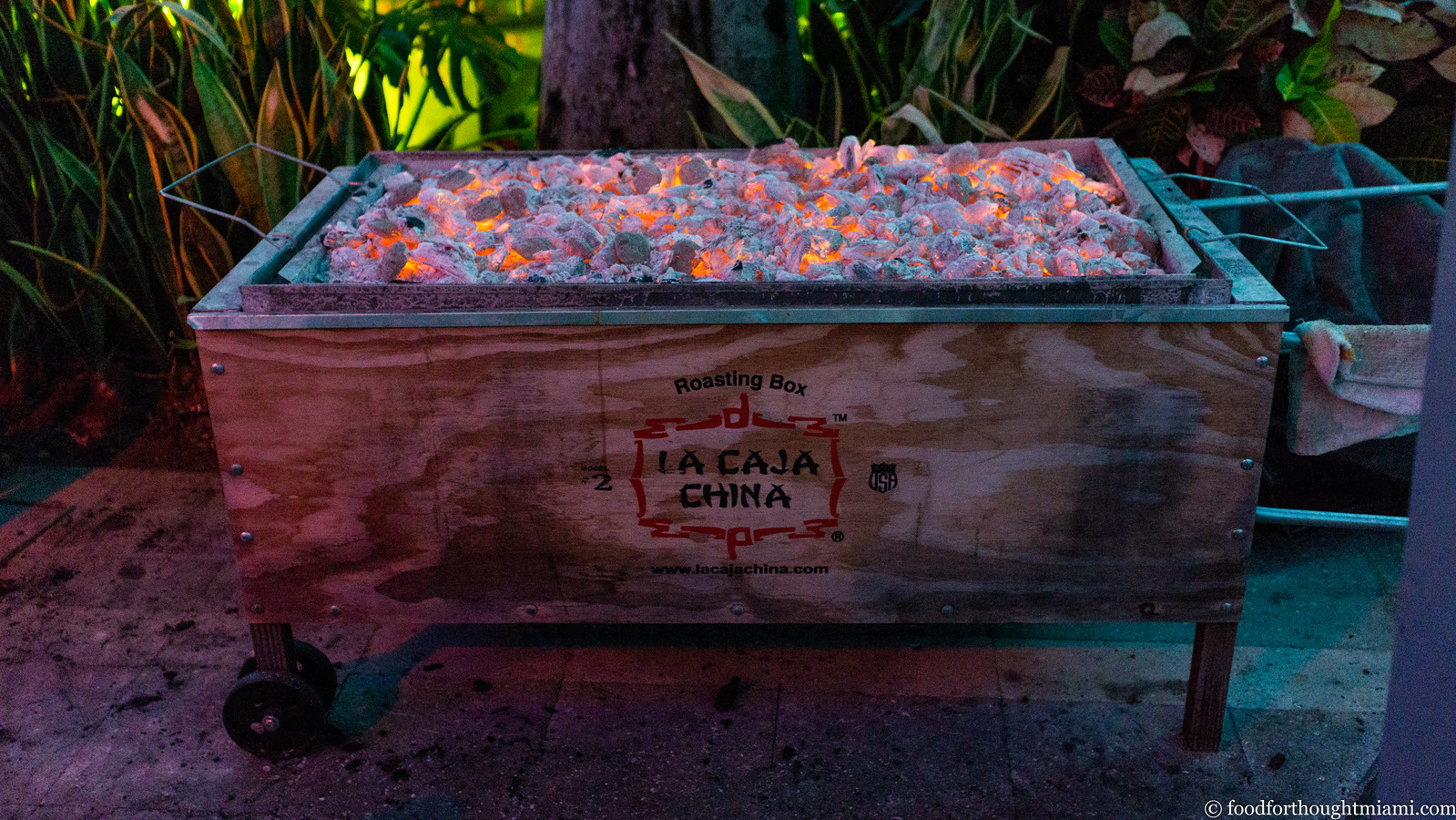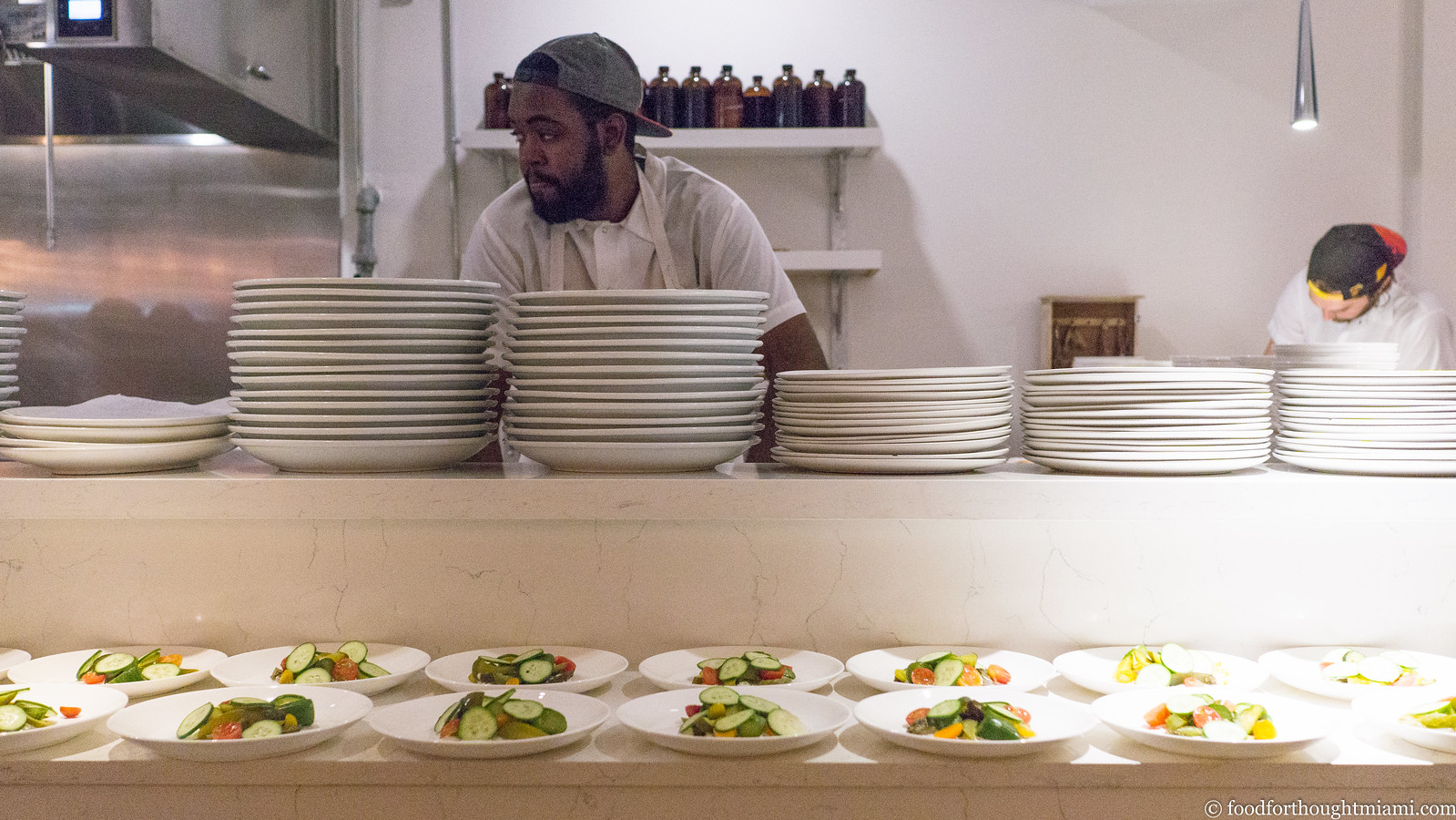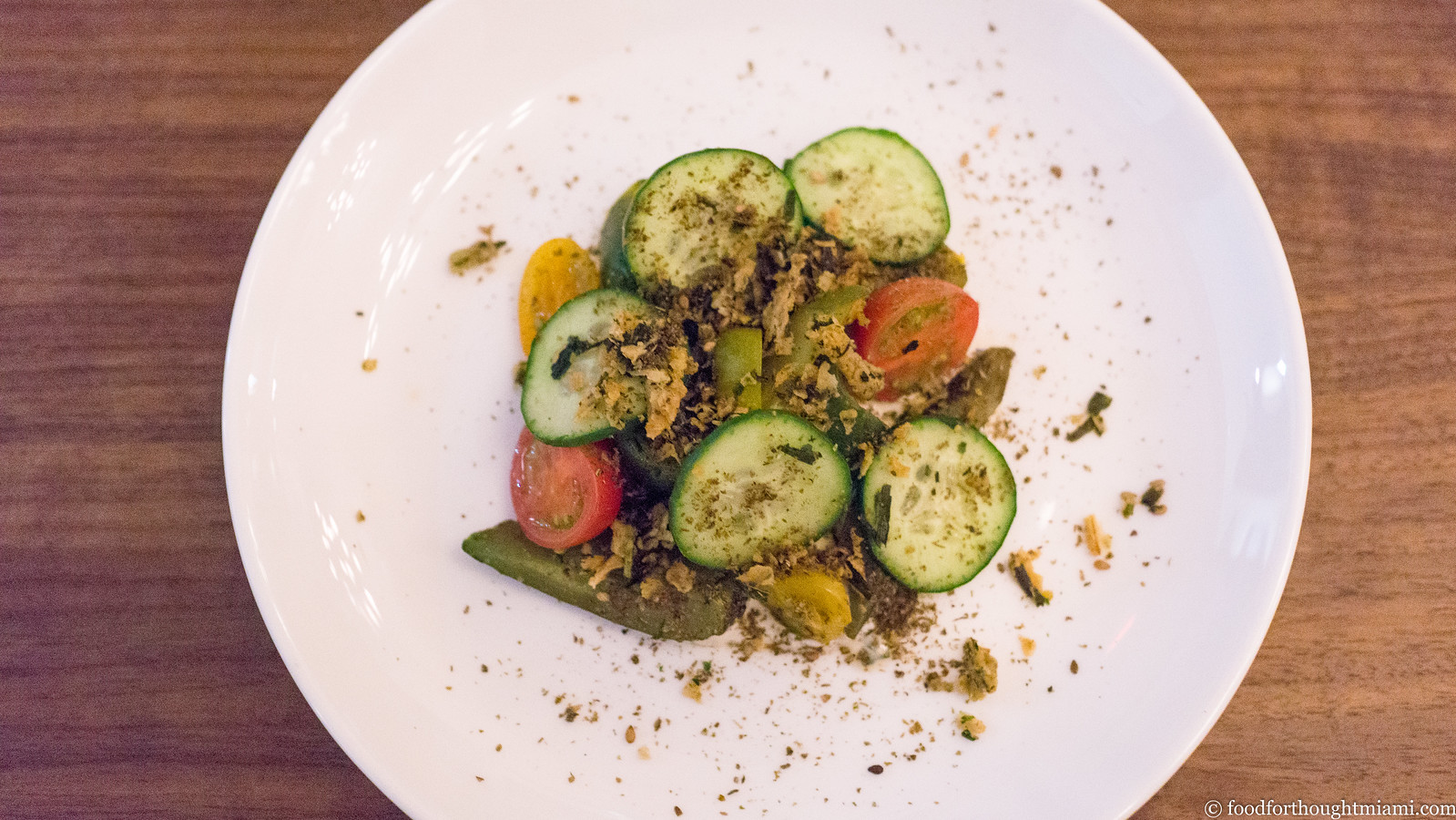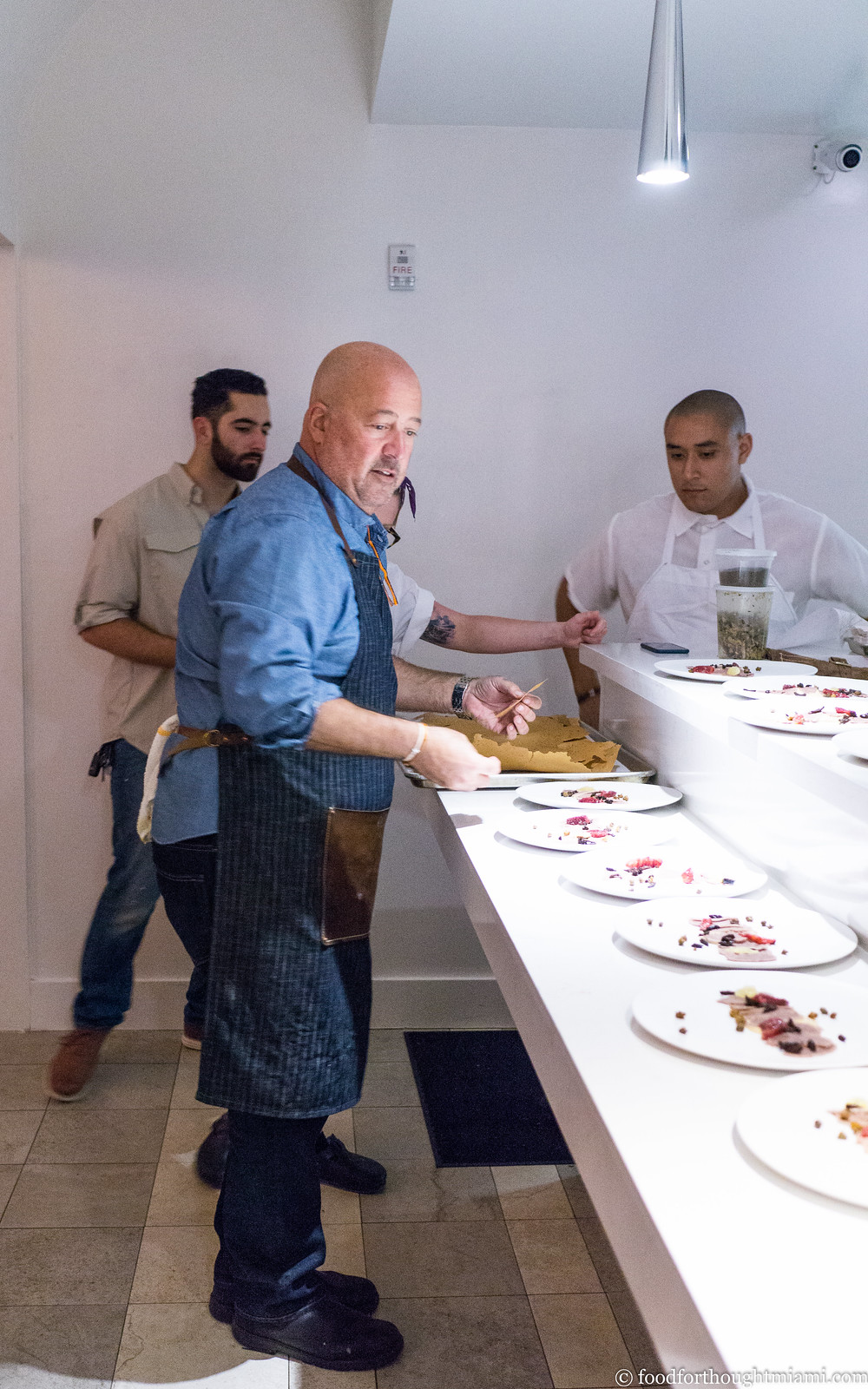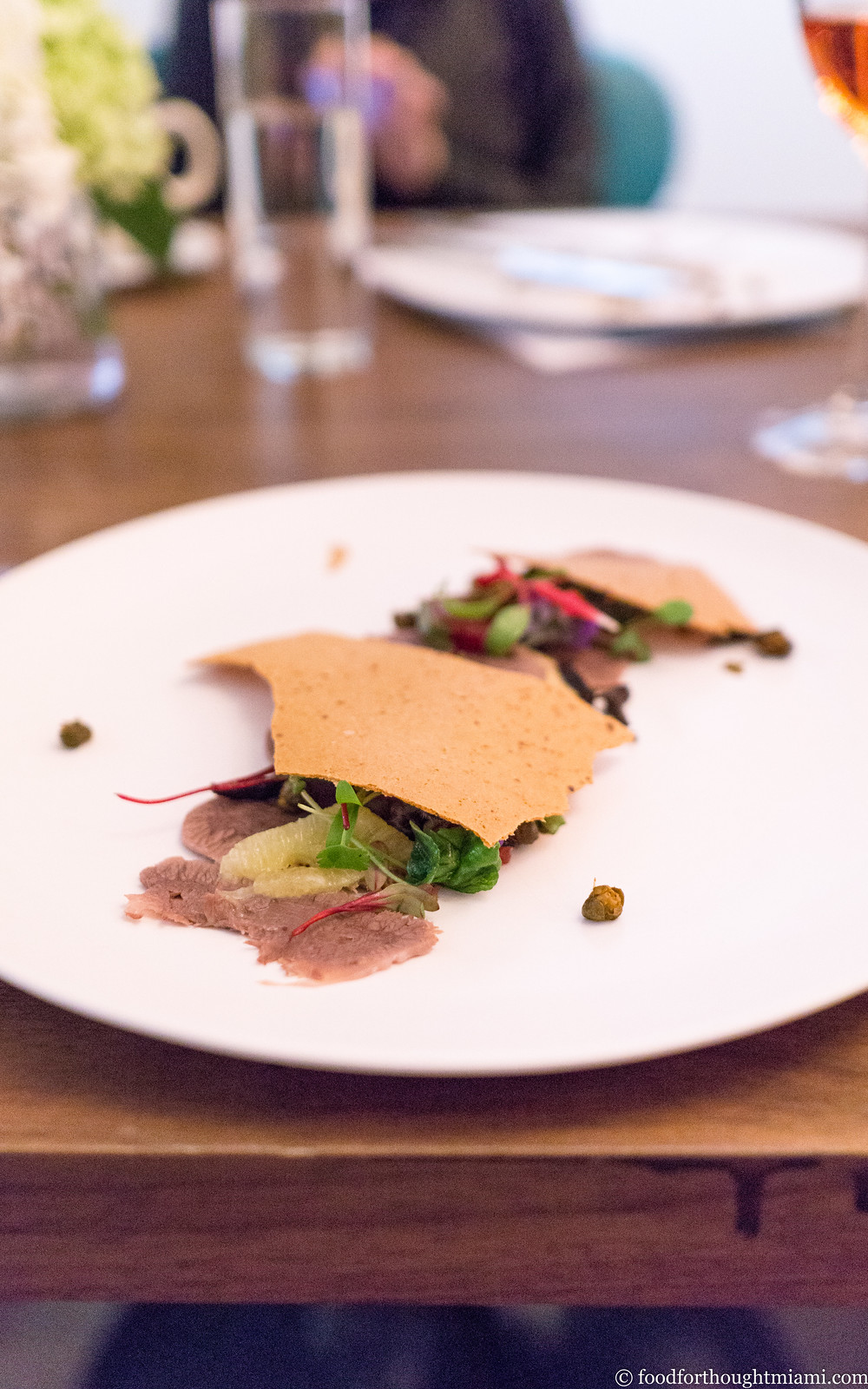I started buying vegetables from a CSA two years ago, and set out with the best of intentions to blog the manner of consumption of each week's vegetable share. In year one, that lasted for about six weeks, with sporadic posts thereafter. In year two, I faded after only two weeks. You can observe, and then mock, my feeble output by searching the "CSA" label.
I'm back at it again this year, but with a new supplier. I signed up this season for a CSA with Little River Market Garden, a pocket-sized little farm on a residential lot near Miami's Little River. It's less than five miles away from my house, which somehow seemed more in keeping with the spirit of a CSA. It's nice to be able to pick up right from the farm, instead of a neighborhood drop-off point, to see the stuff growing right there, and to say hi every week to the person growing it (Hi Muriel!).
The season just started this week - yes, South Florida growing seasons are completely inverted, so we'll be getting summer vegetables like zucchini and tomatoes in December - and I picked up our first share from Little River last Saturday.
Black sapotes, green beans, breakfast radishes, a leafy green whose identity I've already forgotten, roselle leaves (a/k/a Jamaican sorrel a/k/a hibiscus), lemongrass, ripe and unripe papaya, two different kinds of zucchini, oregano, and purple long beans. Not a bad haul.
The thing that I both enjoy, and which drives me to distraction, about doing a CSA is the question that is posed every week: "What the heck am I going to do with this stuff?" Sometimes it's a vegetable I've never cooked before, like these long beans. Or it may be something I don't really get excited over. Zucchini, I'm looking at you.
Now, I don't kid myself - I'm a much better eater than I am a cook. So to the extent I can keep this going longer than two weeks, I'm not promising much in the way of culinary fireworks. But if I can keep it up, then these posts will at least provide a bit of a window into our wacky, upside-down growing season here in South Florida, and maybe even a tiny bit of inspiration too.
(continued ...)
Showing posts sorted by relevance for query black sapote. Sort by date Show all posts
Showing posts sorted by relevance for query black sapote. Sort by date Show all posts
Thursday, November 24, 2011
Tuesday, January 12, 2010
CSA Week 5 - Black Sapote Ice Cream
Ice cream machine! Ice cream machine! Yes, as warned, I decided it was time to break out the ice cream maker to deal with the black sapotes in last week's CSA bag. The basic recipe: flesh of two ripe black sapotes; 1 cup heavy cream; 1 cup milk; about 1/3 cup sugar (I happened to have sitting around some extra sugar which had been used to coat some candied orange peels, which was imbued with the scent of the oranges' oil, and used that); zest of one clementine. (I was aiming roughly for the flavor profile of the long-gone Baskin-Robbins mandarin chocolate sherbet, the odes of which I've previously sung). Mixed well to incorporate the sapote into the cream, chilled, and then into the ice cream maker.
I'm actually pretty pleased with the results. The flavor of the sapote is perhaps somewhat indistinct, possibly because I'm not accustomed enough to it to recognize it. But there are some dark chocolatey notes, as well as some dark fruit notes like date or dried fig. The orange is not overwhelming but is noticeable and lightens up the flavor some. If I were to be generous, I might say the flavors are reminiscent of a port. I might try a little agar-agar next time to improve the texture. I tried it with a spoonful of arequipe, a Colombian dulce de leche type product with coconut that I found in the grocery store; not bad. I may also try with some candied kumquats to up the chocolatey/citrusy quotient.
The real test will come when I have the kids try it tonight.
I'm actually pretty pleased with the results. The flavor of the sapote is perhaps somewhat indistinct, possibly because I'm not accustomed enough to it to recognize it. But there are some dark chocolatey notes, as well as some dark fruit notes like date or dried fig. The orange is not overwhelming but is noticeable and lightens up the flavor some. If I were to be generous, I might say the flavors are reminiscent of a port. I might try a little agar-agar next time to improve the texture. I tried it with a spoonful of arequipe, a Colombian dulce de leche type product with coconut that I found in the grocery store; not bad. I may also try with some candied kumquats to up the chocolatey/citrusy quotient.
The real test will come when I have the kids try it tonight.
Friday, January 22, 2010
CSA - Catching Up
As a result of travel and other distractions I've sort of fallen off the wagon with my CSA updates. There's not been anything revolutionary going on in the kitchen anyway, so you're not missing out on much.
Possibly my favorite item from the Week 6 delivery were adorable French breakfast radishes, pointy little guys with a pinkish-red blush on one end and white on the other end. They needed nothing more than some good butter, good salt, and good bread. The betel leaves were used in a successful repeat preparation of the bò lá lốt, with bok choy leaves serving as an effective substitute wrapper when the betel leaves were used up. The canistels from Week 6 finally ripened (like the black sapotes, they need to be really soft - seemingly ready to be thrown out - before they're ripe enough to eat) and I've harvested the flesh on these which is in the freezer, potentially turning into a flan this weekend. A word of warning - I wouldn't use your best knife with these, the skin has a sticky substance that really doesn't want to wash off the blade. Nothing particularly exciting happened to the rest of Week 6.
I was out of town this past weekend and Mrs. F did the pick-up, so no picture of Week 7 (though Redland Organics has the newsletter online). This was the "freeze" week. While the greens and cabbage looked none the worse for wear, the citrus was spotty - and sour! Unfortunately the carambola was too. Mrs. F cooked off the kale with some andouille and white beans, and it was delicious. I've got some more ideas for the black sapote. And the avocado may get used for a sample of the Alton Brown "sardine and avocado sandwich diet."
It will be interesting to see how much the cold snap is going to affect the rest of the season's harvest.
Possibly my favorite item from the Week 6 delivery were adorable French breakfast radishes, pointy little guys with a pinkish-red blush on one end and white on the other end. They needed nothing more than some good butter, good salt, and good bread. The betel leaves were used in a successful repeat preparation of the bò lá lốt, with bok choy leaves serving as an effective substitute wrapper when the betel leaves were used up. The canistels from Week 6 finally ripened (like the black sapotes, they need to be really soft - seemingly ready to be thrown out - before they're ripe enough to eat) and I've harvested the flesh on these which is in the freezer, potentially turning into a flan this weekend. A word of warning - I wouldn't use your best knife with these, the skin has a sticky substance that really doesn't want to wash off the blade. Nothing particularly exciting happened to the rest of Week 6.
I was out of town this past weekend and Mrs. F did the pick-up, so no picture of Week 7 (though Redland Organics has the newsletter online). This was the "freeze" week. While the greens and cabbage looked none the worse for wear, the citrus was spotty - and sour! Unfortunately the carambola was too. Mrs. F cooked off the kale with some andouille and white beans, and it was delicious. I've got some more ideas for the black sapote. And the avocado may get used for a sample of the Alton Brown "sardine and avocado sandwich diet."
It will be interesting to see how much the cold snap is going to affect the rest of the season's harvest.
Saturday, January 9, 2010
CSA Week 5 - catching up
What with holidays and travel I have sort of been falling behind, both in blogging and actually consuming some of my CSA share. For better or worse, a lot of this stuff is very easy to deal with though the results are not particularly notable. Greens get cooked down with some onions and pork products. Lettuces and tomatoes go into salads or on top of flatbreads. Those harukei turnips from last week (actually week before last now) are very nice as is; sliced thin they have a nice wet crunch like a daikon and a bit of a peppery bite like a radish. Week 5, pictured above, brought a head of cabbage, a head of lettuce, some beets, plum tomatoes (Little Miss F got excited for these and immediately started eating one like an apple), dill, oyster mushrooms (I think Mrs. F put these in a frittata) and more black sapote. Fortunately some of these items like the beets and cabbage are pretty hearty and seem to be coping well in the fridge despite my neglect of them.
On an unrelated note, if you are accustomed to getting FFT through an RSS feed, I have switched from doing a full feed to just a short-form feed. Sorry for any inconvenience, but there is a website which is pirating my content without linking back to the site, without my permission, after being asked to stop doing so. So, in the hope that they "aggregate" this post as well: www.foodsherpa.com are a bunch of rude, thieving, copyright-violating douchebags. Please do not follow that link and reward their douchebaggery. That is all.
On an unrelated note, if you are accustomed to getting FFT through an RSS feed, I have switched from doing a full feed to just a short-form feed. Sorry for any inconvenience, but there is a website which is pirating my content without linking back to the site, without my permission, after being asked to stop doing so. So, in the hope that they "aggregate" this post as well: www.foodsherpa.com are a bunch of rude, thieving, copyright-violating douchebags. Please do not follow that link and reward their douchebaggery. That is all.
Tuesday, June 8, 2010
CSA - Reflections on a Season
It's been more than a month since I picked up the last box for our CSA (Community Supported Agriculture) share through Bee Heaven Farm. I've always been amused at how South Florida's growing season fades away right as the rest of the country's season begins: it was literally about a week after our last delivery that the rest of the blogosphere started to bloom with discussions of CSA programs and farmer's markets. For us here in South Florida, it's mostly mangoes, lychees and avocados until the fall.
For those who are unfamiliar, Community Supported Agriculture is a way of shortening the chain between farmer and end-consumer. Before the growing season begins, farmers sell subscriptions to a share of their product for the season; then over the course of the season, the customers get their share - whatever happens to be harvested at that particular time - direct from the farms. The Bee Heaven Farm CSA that I subscribed to actually consolidates the products of several local farms, and delivers them to several drop-off points throughout Miami-Dade and Broward Counties.
The season was for twenty weeks total, and you have the option of subscribing to a "full share" or a "half share." For those interested in the nitty-gritty details, the price of a full share was $630, the price of a half-share $375. With an extra $40 added for using a Miami-Dade pick-up location, our total cost for a half-share amounted to a little more than $20/week. To get an idea of what that gets you, you can look at the newsletter archives, which listed each week what was in the box. That may seem a bit steep, but during the season, the CSA basically supplanted our grocery store vegetable-buying (for a family of four who, I will confess, were not cooking at home nearly every night of the week), other than for staples such as onions, carrots and celery (each of which would make occasional appearances in the box, too).
This was my first season trying a CSA, and I'll admit I did so with some trepidation. I'm an enthusiastic but infrequent cook, and the notion of plowing through an entire box of vegetables every week was somewhat daunting. In addition, one of the mixed blessings of CSA programs is that it is quite literally market-driven. Unlike going to the grocery store, or even a farmers' market, where you can go in with a fixed notion of what you want to make that night, what's in the box - and what you'll be cooking - is dictated entirely by what the farms have planted and what's ready for harvest that particular week.
Miami has, for the most part, struggled to really support genuine farmers' markets. Often what style themselves as "farmers' markets" are really nothing other than folks who buy and resell produce from wholesalers, along with an assortment of vendors selling flowers, candles, and various knick-knacks. You'll often be hard-pressed to find an actual farmer, or even sometimes any produce that has actually come from local farms. That may be changing some with Bee Heaven and others' participation in the Pinecrest Farmers Market this past spring, and the nascent Roots in the City market in Overtown. But even in places where farmers' markets are better supported, the "Where's the Farmer?" question still comes up, and it may well be that programs like CSAs are, in some places, anyway, a more efficient means of doing business than farmers' markets.
I can't claim that I managed to cook everything every week. I also can't claim that I enjoyed everything. Truth is, while I am almost entirely omnivorous, there are some things I don't get too excited about: green peppers, zucchini, and yellow squash are a few of the things on that short list. On the other hand, we love just about any form of greens, and there were many which made regular appearances in the box: swiss chard, dandelion greens, collards, calalloo, bok choy and more. I adored the little French breakfast radishes we got occasionally, even if they were primarily an excuse to break out some butter and good salt. We learned that our resident tropical fruit maven, Little Miss F, loved canistel; though even she never got truly excited over black sapote.
(continued ...)
For those who are unfamiliar, Community Supported Agriculture is a way of shortening the chain between farmer and end-consumer. Before the growing season begins, farmers sell subscriptions to a share of their product for the season; then over the course of the season, the customers get their share - whatever happens to be harvested at that particular time - direct from the farms. The Bee Heaven Farm CSA that I subscribed to actually consolidates the products of several local farms, and delivers them to several drop-off points throughout Miami-Dade and Broward Counties.
The season was for twenty weeks total, and you have the option of subscribing to a "full share" or a "half share." For those interested in the nitty-gritty details, the price of a full share was $630, the price of a half-share $375. With an extra $40 added for using a Miami-Dade pick-up location, our total cost for a half-share amounted to a little more than $20/week. To get an idea of what that gets you, you can look at the newsletter archives, which listed each week what was in the box. That may seem a bit steep, but during the season, the CSA basically supplanted our grocery store vegetable-buying (for a family of four who, I will confess, were not cooking at home nearly every night of the week), other than for staples such as onions, carrots and celery (each of which would make occasional appearances in the box, too).
This was my first season trying a CSA, and I'll admit I did so with some trepidation. I'm an enthusiastic but infrequent cook, and the notion of plowing through an entire box of vegetables every week was somewhat daunting. In addition, one of the mixed blessings of CSA programs is that it is quite literally market-driven. Unlike going to the grocery store, or even a farmers' market, where you can go in with a fixed notion of what you want to make that night, what's in the box - and what you'll be cooking - is dictated entirely by what the farms have planted and what's ready for harvest that particular week.
Miami has, for the most part, struggled to really support genuine farmers' markets. Often what style themselves as "farmers' markets" are really nothing other than folks who buy and resell produce from wholesalers, along with an assortment of vendors selling flowers, candles, and various knick-knacks. You'll often be hard-pressed to find an actual farmer, or even sometimes any produce that has actually come from local farms. That may be changing some with Bee Heaven and others' participation in the Pinecrest Farmers Market this past spring, and the nascent Roots in the City market in Overtown. But even in places where farmers' markets are better supported, the "Where's the Farmer?" question still comes up, and it may well be that programs like CSAs are, in some places, anyway, a more efficient means of doing business than farmers' markets.
I can't claim that I managed to cook everything every week. I also can't claim that I enjoyed everything. Truth is, while I am almost entirely omnivorous, there are some things I don't get too excited about: green peppers, zucchini, and yellow squash are a few of the things on that short list. On the other hand, we love just about any form of greens, and there were many which made regular appearances in the box: swiss chard, dandelion greens, collards, calalloo, bok choy and more. I adored the little French breakfast radishes we got occasionally, even if they were primarily an excuse to break out some butter and good salt. We learned that our resident tropical fruit maven, Little Miss F, loved canistel; though even she never got truly excited over black sapote.
(continued ...)
Saturday, March 5, 2016
Cobaya SoBeWFF 2016 with Chefs Alex Chang, Andrew Zimmern, Vinny Dotolo, Jon Shook and Carlo Mirarchi
Last year, Cobaya Gourmet Guinea Pigs brought its talents to South Beach, teaming up for the first time with the South Beach Wine and Food Festival to put on a dinner together. That one worked out pretty nicely, so we decided to do it again.
This time around, Chef Alex Chang (an alumnus of Cobaya Experiment #53) of the Vagabond on Biscayne Boulevard played host, Andrew Zimmern of Bizarre Foods made a repeat appearance, and Carlo Mirarchi of Blanca, the exceptional tasting-menu sibling to Roberta's Pizza in Brooklyn, joined us, along with Jon Shook and Vinny Dotolo, of Animal, Son of a Gun and several more new L.A. restaurants.
It was another great night: an ideal location in the refurbished Vagabond Hotel, some great chefs serving some great dishes, and a really nice crowd that included a lot of Cobaya veterans, as well as a good number of SobeFest attendees who were new to our little experiments. We don't really get the chance to do anything of this size (over 100 guests) on our own, so it was a great opportunity to reach a broader group.
Here's how the evening went:
(You can see all my pictures in this Cobaya SoBeWFF 2016 flickr set).
The festivities started with drinks at the bar by the Vagabond pool, including a concoction featuring Lustau manzanilla shery,[1] Pimm's No. 1 and grapefruit soda garnished with mint, cucumber and berries.
As the crowd gathered, bites from the chefs made their way around: from the Animal boys, crisp mini tacos filled with raw hamachi doused in fish sauce vinaigrette, with peanuts and avocado; a silky vichyssoise adorned with a citrus-cured oyster from Zimmern; shaved ribeye with black sapote and burnt eggplant folded into a nasturtium leaf, and snap peas bathed in a spicy leek oil and goat's milk from Chef Chang.
Behind the bar, a caja china loaded with glowing coals was a hint of things to come.
As the group meandered their way into the dining room, the kitchen was already busy plating the first course. Jon and Vinny led off with a dish that combined cucumber in various fresh and pickled forms, together with sweet juicy cherry tomatoes and pickled peppers, all over a pickled ramp ranch dressing and dusted with a za'atar spiced crumble. There was a great mix of fresh and tart, pickle-y flavors here, that za'atar spice blend could go on just about anything and make it great, and anyone who doesn't love ranch dressing is just missing out.
Like he did last year, Zimmern once again more than held his own among a group of incredibly talented restaurant chefs, serving what was my dish of the night: a spin on vitello tonnato that layered thin-sliced poached veal tongue over an anchovy-laden tuna and mayo dressing, paired with some bright fresh citrus, briny olives, chile oil-spiked fried capers, and delicate chickpea crackers. I said a bit more about the dish – and Zimmern's clever presentation of it – in an earlier post, when it was the "best thing I ate last week."
(continued ...)
This time around, Chef Alex Chang (an alumnus of Cobaya Experiment #53) of the Vagabond on Biscayne Boulevard played host, Andrew Zimmern of Bizarre Foods made a repeat appearance, and Carlo Mirarchi of Blanca, the exceptional tasting-menu sibling to Roberta's Pizza in Brooklyn, joined us, along with Jon Shook and Vinny Dotolo, of Animal, Son of a Gun and several more new L.A. restaurants.
It was another great night: an ideal location in the refurbished Vagabond Hotel, some great chefs serving some great dishes, and a really nice crowd that included a lot of Cobaya veterans, as well as a good number of SobeFest attendees who were new to our little experiments. We don't really get the chance to do anything of this size (over 100 guests) on our own, so it was a great opportunity to reach a broader group.
Here's how the evening went:
(You can see all my pictures in this Cobaya SoBeWFF 2016 flickr set).
The festivities started with drinks at the bar by the Vagabond pool, including a concoction featuring Lustau manzanilla shery,[1] Pimm's No. 1 and grapefruit soda garnished with mint, cucumber and berries.
As the crowd gathered, bites from the chefs made their way around: from the Animal boys, crisp mini tacos filled with raw hamachi doused in fish sauce vinaigrette, with peanuts and avocado; a silky vichyssoise adorned with a citrus-cured oyster from Zimmern; shaved ribeye with black sapote and burnt eggplant folded into a nasturtium leaf, and snap peas bathed in a spicy leek oil and goat's milk from Chef Chang.
Behind the bar, a caja china loaded with glowing coals was a hint of things to come.
Like he did last year, Zimmern once again more than held his own among a group of incredibly talented restaurant chefs, serving what was my dish of the night: a spin on vitello tonnato that layered thin-sliced poached veal tongue over an anchovy-laden tuna and mayo dressing, paired with some bright fresh citrus, briny olives, chile oil-spiked fried capers, and delicate chickpea crackers. I said a bit more about the dish – and Zimmern's clever presentation of it – in an earlier post, when it was the "best thing I ate last week."
(continued ...)
Saturday, May 7, 2011
Cobakayapaz - Cobaya Dinner with Chefs Richard Hales, Vanessa Paz
It was almost exactly a year ago that we did our "Cobaya in the Night Kitchen" midnight dinner at Sakaya Kitchen. At that point, Sakaya had only been open a few months. The late-night diners who came out for that event got a good sampling of what was going on there, with Chef Richard Hales mixing in some standard menu items (his Filipino egg rolls and pork buns) and some more adventurous twists (Korean fried sweetbreads, "Chim Quay" quail).
Chef Hales has been itching to do another Cobaya dinner for a few months now, and we finally put it together. This past Monday, he rolled the Sakaya Kitchen truck (truck #2 for him, with the Dim Ssam a Gogo truck being the first in the fleet) over to Villa 221 to serve a small group of 20 guinea pigs. As an extra bonus, he brought in pastry chef Vanessa Paz of Michy's to do desserts.
You can see all the pictures from the dinner in this "Cobakayapaz" flickr set.
Villa 221, located just north of downtown Miami just a few blocks past the Performing Arts Center, was a gorgeous venue for the dinner, with a nice breeze keeping things cool enough for outdoor dining, and the group small enough to fit around one open-square table beneath the trees.
Chef Hales' cooking at Sakaya takes a good number of its culinary cues from Korea - bulgogi, ssams, ssamjang and kimchi all play prominent roles - but often looks elsewhere, both East (baos, Filipino egg rolls) and West (the incredible Bulgogi Burger, spicy tater tots) for inspiration. This Cobaya dinner was even more diverse, with dishes that drew on Vietnamese, Thai, Japanese, Italian and even American Southern motifs. Here is the menu he and Chef Paz put together:
His first course was a small plate of airy, crispy pork rinds drizzled with nuac mau. Cleverly combining a Southern snack stable with a classic Vietnamese caramel sauce often used as a marinade or glaze for meat dishes, this dish sounded a couple notes that would be prevalent throughout much of the meal: (1) the mash-up of culinary genres, and (2) the interplay of savory and sweet. Many of Chef Hales' dishes play in that neighborhood between sweet and savory (Sakaya's honey-orange ribs have been Frod Jr.'s chosen dessert on more than one evening), and we would see much of that in this menu.
The next dish was a take on the Thai classic som tam, or papaya salad, which traditionally uses unripe green papaya shredded into a fine julienne, dressed with lime juice, fish sauce, sugar and chiles, often tossed with some tomatoes and peanuts. Chef Hales' version used ripe pink-fleshed papaya,[1] plump, halved grape tomatoes, a sweet, crunchy peanut brittle, and sprigs of local mint and cilantro. Clean, light and refreshing, I would have welcomed even more spice and tartness to balance out the sweet of the papaya and the brittle.
This mushroom brioche "toast" fell somewhere between a French canapé and a Chinese shrimp toast, all the while borrowing the flavors and accompaniments of Sakaya's delicious pork buns: ssamjang mayo, thinly sliced pickled cucumbers, and a shower of fresh cilantro sprigs and green onions. This was good, though a bit heavy, plus these flavors were already very familiar to those of us for whom the Sakaya pork buns are a weekly staple.
The next course veered into more unfamiliar territory: burrata, served with a "panzanella" of blackberries and toasted brioche, dressed with sesame oil and Fuji vinegar and a julienne of fresh basil. This is the kind of dish I love: an unexpected combination that seems to make no sense and perfect sense at the same time. The cheese was just gorgeous, perhaps the freshest-tasting burrata I've had, luscious and exploding with creaminess. The "panzanella," subbing plump blackberries for tomatoes, provided a nice foil for the burrata, crisp cubes of bread giving some substance and the tangy blackberries some sweet, acidic contrast, further reinforced by the Fuji vinegar, all while the sesame oil provided an additional layer of lush richness. Italian and Asian flavor profiles don't meet very often; perhaps that's a missed opportunity. This was one of my favorite dishes of the evening.[2]
(continued ...)
Chef Hales has been itching to do another Cobaya dinner for a few months now, and we finally put it together. This past Monday, he rolled the Sakaya Kitchen truck (truck #2 for him, with the Dim Ssam a Gogo truck being the first in the fleet) over to Villa 221 to serve a small group of 20 guinea pigs. As an extra bonus, he brought in pastry chef Vanessa Paz of Michy's to do desserts.
You can see all the pictures from the dinner in this "Cobakayapaz" flickr set.
Villa 221, located just north of downtown Miami just a few blocks past the Performing Arts Center, was a gorgeous venue for the dinner, with a nice breeze keeping things cool enough for outdoor dining, and the group small enough to fit around one open-square table beneath the trees.
Chef Hales' cooking at Sakaya takes a good number of its culinary cues from Korea - bulgogi, ssams, ssamjang and kimchi all play prominent roles - but often looks elsewhere, both East (baos, Filipino egg rolls) and West (the incredible Bulgogi Burger, spicy tater tots) for inspiration. This Cobaya dinner was even more diverse, with dishes that drew on Vietnamese, Thai, Japanese, Italian and even American Southern motifs. Here is the menu he and Chef Paz put together:
Nuoc Mau Spiced Pork Rinds
Pickled Papaya, Peanut Brittle, Organic Tomatoes, Local Mint
Mushroom Brioche "Toast," Ssamjang Mayo, House Cucumber Pickle, Local Cilantro
Burrata, Blackberry "Panzanella," Sesame Oil, Fuji Vinegar, Brioche, Maple, Basil
Fried Baby Artichokes, Quail Yolk, Fish Roe
Colossal Shrimp, Blistered Organic Shishito Pepper, Miso Cauliflower Purée
Kurobuta Pork Belly, Peach Gastrique, Grilled Ramps, Corn Croquetas, Black Eyed Peas
Miso Chocolate Brûlée, Hot Chocolate Foam, Spicy Pecan Crumble
Pineapple Pie, Coconut Ice Cream
Dulce de Leche Panna Cotta, Pistachio Sponge Cake, Dry Meringue
Shot of Strawberry Sake
"PB&J" Peanut Butter Ice Cream Sandwich
Green Tea Mascarpone Cake, Sapote
Chocolate Doughnut, Passion Fruit Sauce
His first course was a small plate of airy, crispy pork rinds drizzled with nuac mau. Cleverly combining a Southern snack stable with a classic Vietnamese caramel sauce often used as a marinade or glaze for meat dishes, this dish sounded a couple notes that would be prevalent throughout much of the meal: (1) the mash-up of culinary genres, and (2) the interplay of savory and sweet. Many of Chef Hales' dishes play in that neighborhood between sweet and savory (Sakaya's honey-orange ribs have been Frod Jr.'s chosen dessert on more than one evening), and we would see much of that in this menu.
The next dish was a take on the Thai classic som tam, or papaya salad, which traditionally uses unripe green papaya shredded into a fine julienne, dressed with lime juice, fish sauce, sugar and chiles, often tossed with some tomatoes and peanuts. Chef Hales' version used ripe pink-fleshed papaya,[1] plump, halved grape tomatoes, a sweet, crunchy peanut brittle, and sprigs of local mint and cilantro. Clean, light and refreshing, I would have welcomed even more spice and tartness to balance out the sweet of the papaya and the brittle.
This mushroom brioche "toast" fell somewhere between a French canapé and a Chinese shrimp toast, all the while borrowing the flavors and accompaniments of Sakaya's delicious pork buns: ssamjang mayo, thinly sliced pickled cucumbers, and a shower of fresh cilantro sprigs and green onions. This was good, though a bit heavy, plus these flavors were already very familiar to those of us for whom the Sakaya pork buns are a weekly staple.
The next course veered into more unfamiliar territory: burrata, served with a "panzanella" of blackberries and toasted brioche, dressed with sesame oil and Fuji vinegar and a julienne of fresh basil. This is the kind of dish I love: an unexpected combination that seems to make no sense and perfect sense at the same time. The cheese was just gorgeous, perhaps the freshest-tasting burrata I've had, luscious and exploding with creaminess. The "panzanella," subbing plump blackberries for tomatoes, provided a nice foil for the burrata, crisp cubes of bread giving some substance and the tangy blackberries some sweet, acidic contrast, further reinforced by the Fuji vinegar, all while the sesame oil provided an additional layer of lush richness. Italian and Asian flavor profiles don't meet very often; perhaps that's a missed opportunity. This was one of my favorite dishes of the evening.[2]
(continued ...)
Tuesday, January 26, 2010
CSA Week 6 - Canistel Flan
The more I did my homework on the canistels that came with the Week 6 CSA drop-off,[*] the more convinced I became that a flan was the direction to go. The fruit is also known as the egg fruit because when ripe it has a vivid yellow-orange color, and the flesh is supposed to have a texture similar to hard-boiled egg yolk. It is of the same family as the mamey sapote and bears similarities both in shape and in flavor. When I tasted a bit, I picked up some of the "egg-y" flavor (reminiscent of a Chinese custard bun), plus sweet potato or pumpkin and almond notes similar to those in mamey.
Like the black sapotes we've gotten in other weeks, canistels must go very soft to be fully ripe, and the fruit bowl of late has been looking like something out of a Peter Greenaway movie (I should have taken a picture). Of course, they rarely cooperate by ripening simultaneously, so I harvested the flesh of these as they ripened and froze it until they were all ready. Fortunately, Little Miss F liked the flavor of the canistel much moreso than the black sapotes (she's a big fan of mamey) so I had a willing assistant in preparing this.
I looked mostly at pumpkin flan (a/k/a flan de calabaza) recipes for inspiration, and after considering several variations went with the following (look, an actual recipe!):
Note that the color is almost entirely from the canistels, not the eggs. Then, make Thomas Keller proud - pour it through a strainer:
Next, the caramel. Put the 3/4 cup sugar into a saucepan over medium heat. Some recipes I read said stir constantly. Others said leave it alone until it starts to melt, then stir only occasionally. I eventually learned the latter instructions were the right ones. Just leave it be until the sugar starts to melt, then stir occasionally with a fork to incorporate the rest of the unmelted sugar. I stirred too early and ended up with big lumps that took longer to dissolve. After about ten minutes, you should have liquid (molten! be careful) golden-brown caramel.
Like the black sapotes we've gotten in other weeks, canistels must go very soft to be fully ripe, and the fruit bowl of late has been looking like something out of a Peter Greenaway movie (I should have taken a picture). Of course, they rarely cooperate by ripening simultaneously, so I harvested the flesh of these as they ripened and froze it until they were all ready. Fortunately, Little Miss F liked the flavor of the canistel much moreso than the black sapotes (she's a big fan of mamey) so I had a willing assistant in preparing this.
I looked mostly at pumpkin flan (a/k/a flan de calabaza) recipes for inspiration, and after considering several variations went with the following (look, an actual recipe!):
- Flesh of 3 canistels (~1 cup)
- 4 eggs + 1 egg yolk
- 1 12-oz. can evaporated milk
- 1 14-oz. can sweetened condensed milk
- 2 tsp. vanilla extract
- 1 tsp. ground cinnamon
- 1 tsp. nutmeg (freshly grated)
- 3/4 cup sugar
Note that the color is almost entirely from the canistels, not the eggs. Then, make Thomas Keller proud - pour it through a strainer:
Next, the caramel. Put the 3/4 cup sugar into a saucepan over medium heat. Some recipes I read said stir constantly. Others said leave it alone until it starts to melt, then stir only occasionally. I eventually learned the latter instructions were the right ones. Just leave it be until the sugar starts to melt, then stir occasionally with a fork to incorporate the rest of the unmelted sugar. I stirred too early and ended up with big lumps that took longer to dissolve. After about ten minutes, you should have liquid (molten! be careful) golden-brown caramel.
Friday, August 6, 2010
Norman's 180 - Coral Gables
[sorry, this restaurant has closed]
I'm going to come right out and say it: I don't think I can be entirely objective about Chef Norman Van Aken's new restaurant, Norman's 180. Some of the reminiscing in my last post previewing the restaurant's opening might give some indication why. A dinner nearly twenty years ago at his South Beach restaurant A Mano was one of my first truly memorable meals. His "Feasts of Sunlight" cookbook, published in 1988, was one of the first cookbooks I recall cooking from. Very simply, Chef Van Aken's food has played a not-insignificant part in my personal culinary history.
In the interest of complete disclosure, I should also add that I've attended a (free) friends and family dinner as well as a (free) media preview event at the restaurant,[1] and the chef and I have chatted at those events as well as chance encounters in local tapas bars. Since Norman's 180 officially opened, I've been back a few more times as a paying customer. But try as I might, I've been unable to do so without being "spotted," since Chef Van Aken seems to be working seven days a week. So take this all with as many grains of salt as you deem appropriate.
With that said: Norman's 180 is putting out some delicious, exciting food. It's not perfect. It's not as elegant an experience as the original Norman's in Coral Gables used to be. But it's fun and flavorful, and a welcome return for a South Florida legend.
I won't recite Chef Van Aken's whole biography here. Aside from being a famous chef, he's also a great storyteller, and his life stories are scattered all over his website, from his first gig as a long-haired line cook in 1971, to applying for a job with Charlie Trotter and being mistaken for a truck driver, to Louie's Backyard in Key West, to A Mano on South Beach. But South Floridians probably remember him most fondly for Norman's, his flagship restaurant on the quietest end of sleepy Almeria Avenue in Coral Gables. In its time, Norman's was one of the best restaurants Miami had ever seen, and before it closed almost exactly three years ago in May 2007, it was one of the last local bastions of true "fine dining" still around.
Things change. If you're a proud property owner in Miami, your house is worth about half of what it was worth in 2007. These are not the times for "fine dining." And so it was clearly time for Chef Van Aken to do something different. "Norman's 180" is not "Norman's," with a name that not only conveniently indicates the street address of the restaurant but also suggests a 180 degree turn from the past. Norman's 180 embodies all the current gestalt: it eschews white tablecloths for bare wood tables, it embraces the farm to table ethos, it exalts all that is porcine.
But it is also clearly a Norman Van Aken restaurant. In fact, it's a family venture, with son Justin Van Aken working side by side in the kitchen with the old man.[2] Though he is best known for bringing classical technique to Caribbean flavors and ingredients as a prime instigator of the 1980's "Mango Gang," Chef Van Aken's food has always been globally influenced, willing to draw inspiration from Asia or Africa as readily as South America and the Caribbean if it tastes good. What twenty years ago was called "fusion cuisine" now ought really need no nametag. It's just food, and it's either tasty or not. The menu runs in several directions at once, and sometimes it gets lost amidst all the globe-trotting, but for the most part I've enjoyed the journey so far.
(continued ...)
I'm going to come right out and say it: I don't think I can be entirely objective about Chef Norman Van Aken's new restaurant, Norman's 180. Some of the reminiscing in my last post previewing the restaurant's opening might give some indication why. A dinner nearly twenty years ago at his South Beach restaurant A Mano was one of my first truly memorable meals. His "Feasts of Sunlight" cookbook, published in 1988, was one of the first cookbooks I recall cooking from. Very simply, Chef Van Aken's food has played a not-insignificant part in my personal culinary history.
In the interest of complete disclosure, I should also add that I've attended a (free) friends and family dinner as well as a (free) media preview event at the restaurant,[1] and the chef and I have chatted at those events as well as chance encounters in local tapas bars. Since Norman's 180 officially opened, I've been back a few more times as a paying customer. But try as I might, I've been unable to do so without being "spotted," since Chef Van Aken seems to be working seven days a week. So take this all with as many grains of salt as you deem appropriate.
With that said: Norman's 180 is putting out some delicious, exciting food. It's not perfect. It's not as elegant an experience as the original Norman's in Coral Gables used to be. But it's fun and flavorful, and a welcome return for a South Florida legend.
I won't recite Chef Van Aken's whole biography here. Aside from being a famous chef, he's also a great storyteller, and his life stories are scattered all over his website, from his first gig as a long-haired line cook in 1971, to applying for a job with Charlie Trotter and being mistaken for a truck driver, to Louie's Backyard in Key West, to A Mano on South Beach. But South Floridians probably remember him most fondly for Norman's, his flagship restaurant on the quietest end of sleepy Almeria Avenue in Coral Gables. In its time, Norman's was one of the best restaurants Miami had ever seen, and before it closed almost exactly three years ago in May 2007, it was one of the last local bastions of true "fine dining" still around.
Things change. If you're a proud property owner in Miami, your house is worth about half of what it was worth in 2007. These are not the times for "fine dining." And so it was clearly time for Chef Van Aken to do something different. "Norman's 180" is not "Norman's," with a name that not only conveniently indicates the street address of the restaurant but also suggests a 180 degree turn from the past. Norman's 180 embodies all the current gestalt: it eschews white tablecloths for bare wood tables, it embraces the farm to table ethos, it exalts all that is porcine.
But it is also clearly a Norman Van Aken restaurant. In fact, it's a family venture, with son Justin Van Aken working side by side in the kitchen with the old man.[2] Though he is best known for bringing classical technique to Caribbean flavors and ingredients as a prime instigator of the 1980's "Mango Gang," Chef Van Aken's food has always been globally influenced, willing to draw inspiration from Asia or Africa as readily as South America and the Caribbean if it tastes good. What twenty years ago was called "fusion cuisine" now ought really need no nametag. It's just food, and it's either tasty or not. The menu runs in several directions at once, and sometimes it gets lost amidst all the globe-trotting, but for the most part I've enjoyed the journey so far.
(continued ...)
Subscribe to:
Posts (Atom)






